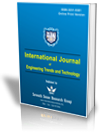An Integrated Approach for AI-Generated Phishing URL Detection Using Reinforcement Learning and Machine Learning
An Integrated Approach for AI-Generated Phishing URL Detection Using Reinforcement Learning and Machine Learning |
||
 |
 |
|
| © 2025 by IJETT Journal | ||
| Volume-73 Issue-11 |
||
| Year of Publication : 2025 | ||
| Author : Sharvari Patil, Narendra M. Shekokar | ||
| DOI : 10.14445/22315381/IJETT-V73I11P116 | ||
How to Cite?
Sharvari Patil, Narendra M. Shekokar,"An Integrated Approach for AI-Generated Phishing URL Detection Using Reinforcement Learning and Machine Learning", International Journal of Engineering Trends and Technology, vol. 73, no. 11, pp.208-226, 2025. Crossref, https://doi.org/10.14445/22315381/IJETT-V73I11P116
Abstract
Among various cyber-attacks in this era of cyber advancement, phishing remains a momentous attack despite unprecedented technological advancements during the past few years. This problem becomes more concerning in view of the exponential rise in users across social platforms, necessitating a sophisticated method to assess web vulnerabilities. The prime mode of phishing attacks is generating URLs through generative AI, which may be misinterpreted as genuine URLs. Hence, it is imperative to devise a model that can differentiate between genuine URLs and AI-generated URLs. The proposed methodology combines Machine Learning and Reinforcement Learning, ensuring continuous learning based on the experiences. The reinforcement learning agent dynamically selects the feature subset using the Q-learning algorithm, and the classification algorithm is also decided at run time. Further, in order to validate the efficiency of the proposed model, a component is developed that generates URLs using AI. During the experimental evaluation, it is observed that the proposed model yields an accuracy of 99.25% outperforming state-of-the-art models. Thus, the proposed model can be widely used to classify AI-generated URLs from genuine URLs at large.
Keywords
Advanced Phishing Technique, AI-generated URLs, Cyber-Attack, Internet Security, Reinforcement Learning.
References
[1] Koceilah Rekouche, “Early Phishing,” arXiv Preprint, pp. 1-9, 2011.
[CrossRef] [Google Scholar] [Publisher Link]
[2] “Phishing Activity Trends Report,” Summary - 1st Quarter 2025, Anti-Phishing Working Group, 2025.
[Publisher Link]
[3] Darren E. Tromblay, Federal Bureau of Investigation, The Handbook of Homeland Security, 1st ed., CRC Press, 2023.
[Google Scholar] [Publisher Link]
[4] Maria Sameen, Kyunghyun Han, and Seong Oun Hwang, “Phishhaven-An Efficient Real-Time AI Phishing URLs Detection System,” IEEE Access, vol. 8, pp. 83425-83443, 2020.
[CrossRef] [Google Scholar] [Publisher Link]
[5] Beauden John, “Adapting to Advanced Threats: Celery Trap's Approach to Combating AI-Generated Phishing Campaigns,” pp. 1-9, 2025.
[Google Scholar]
[6] Alejandro Correa Bahnsen et al., “DeepPhish: Simulating Malicious AI,” 2018 APWG Symposium on Electronic Crime Research, pp. 1-8, 2018.
[Google Scholar]
[7] Nguyet Quang Do et al., “Deep Learning for Phishing Detection: Taxonomy, Current Challenges and Future Directions,” IEEE Access, vol. 10, pp. 36429-36463, 2022.
[CrossRef] [Google Scholar] [Publisher Link]
[8] R.J. Van Geest et al., “The Applicability of a Hybrid Framework for Automated Phishing Detection,” Computers and Security, vol. 139, pp. 1-17, 2024.
[CrossRef] [Google Scholar] [Publisher Link]
[9] Y. Bhanu Prasad, and Venkatesulu Dondeti, “PDSMV3-DCRNN: A Novel Ensemble Deep Learning Framework for Enhancing Phishing Detection and URL Extraction,” Computers and Security, vol. 148, pp. 1-16, 2025.
[CrossRef] [Google Scholar] [Publisher Link]
[10] Felipe Castaño et al., “PhiKitA: Phishing Kit Attacks Dataset for Phishing Websites Identification,” IEEE Access, vol. 11, pp. 40779-40789, 2023.
[CrossRef] [Google Scholar] [Publisher Link]
[11] Abdul Karim et al., “Phishing Detection System through Hybrid Machine Learning Based on URL,” IEEE Access, vol. 11, pp. 36805-36822, 2023.
[CrossRef] [Google Scholar] [Publisher Link]
[12] Antonio Maci et al., “Unbalanced Web Phishing Classification through Deep Reinforcement Learning,” Computers, vol. 12, no. 6, pp. 1-30, 2023.
[CrossRef] [Google Scholar] [Publisher Link]
[13] Orel Lavie, Asaf Shabtai, and Gilad Katz, “A Transferable and Automatic Tuning of Deep Reinforcement Learning for Cost Effective Phishing Detection,” arXiv Preprint, pp. 1-43, 2022.
[CrossRef] [Google Scholar] [Publisher Link]
[14] Hasan Kamal et al., Reinforcement Learning Model for Detecting Phishing Websites, Cybersecurity and Artificial Intelligence, Springer, Cham, pp. 309-326, 2024.
[CrossRef] [Google Scholar] [Publisher Link]
[15] Grega Vrbančič, Iztok Fister, and Vili Podgorelec, “Datasets for Phishing Websites Detection” Data in Brief, vol. 33, pp. 1-7, 2020.
[CrossRef] [Google Scholar] [Publisher Link]
[16] Rodolfo Vieira Valentim et al., “URLGEN-Toward Automatic URL Generation Using GANs,” IEEE Transactions on Network and Service Management, vol. 20, no. 3, pp. 3734-3746, 2023.
[CrossRef] [Google Scholar] [Publisher Link]
[17] Richard S. Sutton, and Andrew G. Barto, Reinforcement Learning: An Introduction, 2nd ed., Adaptive Computation and Machine Learning Series, The MIT Press, 2018.
[Google Scholar] [Publisher Link]
[18] Abdul Basit et al., “A Comprehensive Survey of AI-Enabled Phishing Attacks Detection Techniques,” Telecommunication Systems, vol. 76, no. 1, pp. 139-154, 2021.
[CrossRef] [Google Scholar] [Publisher Link]
[19] Ankit Kumar Jain, and B.B. Gupta, “Phishing Detection: Analysis of Visual Similarity Based Approaches,” Security and Communication Networks, vol. 2017, pp. 1-20, 2017.
[CrossRef] [Google Scholar] [Publisher Link]
[20] Haidar Jabbar, and Samir Al-Janabi, “AI-Driven Phishing Detection: Enhancing Cybersecurity with Reinforcement Learning,” Journal of Cybersecurity and Privacy, vol. 5, no. 2, pp. 1-21, 2025.
[CrossRef] [Google Scholar] [Publisher Link]
[21] Subhash Ariyadasa, Shantha Fernando, and Subha Fernando, “A Reinforcement Learning-Based Intelligent Anti-Phishing Solution to Detect Spoofed Website Attacks,” International Journal of Information Security, vol. 23, no. 2, pp. 1055-1076, 2023.
[CrossRef] [Google Scholar] [Publisher Link]
[22] Richard S. Sutton, and Andrew G. Barto, “Reinforcement Learning,” Journal of Cognitive Neuroscience, vol. 11, no. 1, pp. 126-134, 1999.
[CrossRef] [Google Scholar] [Publisher Link]
[23] H.S. Harisudhan, NLP Transformers-The Backbone of Today’s Language Models, Medium, 2025. [Online]. Available: https://medium.com/@speaktoharisudhan/nlp-transformers-the-backbone-of-todays-language-models-d752a2bf0752
[24] J.O. Schneppat, Transformer Neural Networks, Schneppat AI, 2017. [Online]. Available: https://schneppat.com/transformer-neural-networks.html

